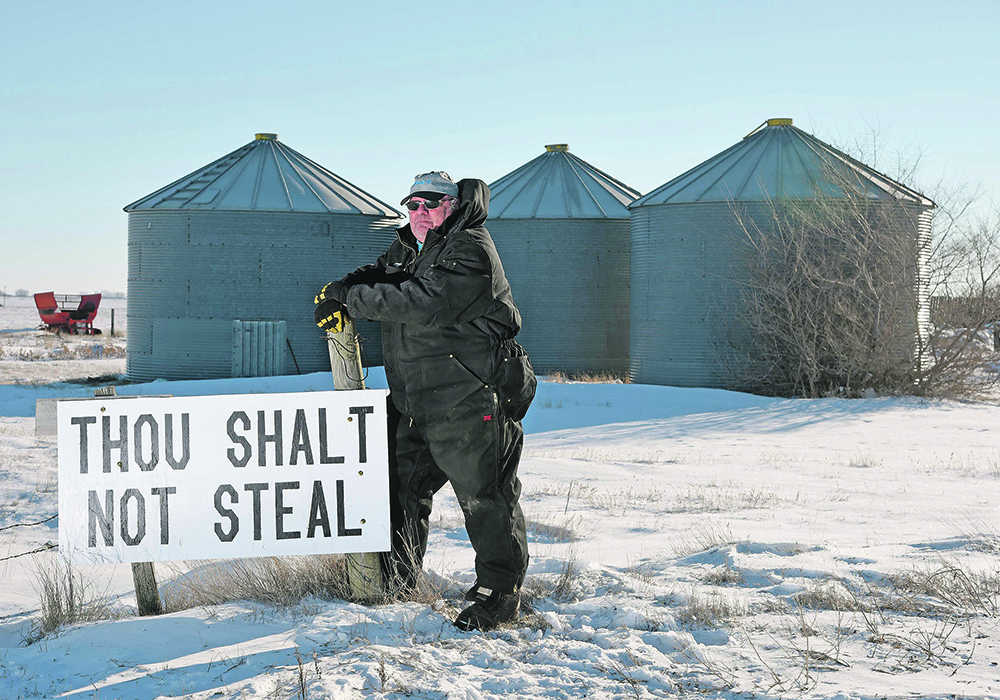We may see more of this crop poaching in Canada and elsewhere in the near future.
(from The Western Producer website):
Security systems and neighbours deter thieves -

Miles Moore put this sign at the entrance to his farm near Outlook, Sask., after 1,800 bushels of canola — $40,000 worth — was stolen from one of his bins this January. Farmers are using technology from social media to security systems to detect and act upon suspicious behaviour.
People have been moving away from rural areas in the Prairies for decades, and those who remain can feel isolated with their closest neighbours sometimes kilometres away.
It’s also much harder for producers to keep their property secure in ever expanding farms, especially when assets are in yards where nobody lives.
If producers do keep assets in yards that are not occupied, they should consider getting a security system, said Sargeant Neil Tremblay of the Battleford, Saskatchewan RCMP department.
“When you have people that happen to be looking for opportunities to steal, (it’s helpful to have) motion cameras or some type of an alarm system when you’re not living at a place where you’re storing equipment,” Tremblay said.
“Those are often where we’re seeing rural property getting targeted.”
A major stumbling block for security systems in remote areas is connectivity because many systems are designed for broadband, which is typically not an option in remote areas. There are, however, other options.
They can use security devices that use long range radio (LoRa) or a Low Power, Wide Area networking (LoRaWAN).
Or something as simple as a camera with cellular connectivity can be a huge help in terms of notifying you when someone pulls into one of your yards.
Images are automatically uploaded from these cameras, so it’s easy to see when there is movement on your property.
“Particularly when you’re dealing in the winter with snowfall when it becomes quite clear that some of these rural properties are not actively being visited very regularly. Those are often the ones that we find targeted,” Tremblay said.
He said cameras are not perfect but they help them apprehend thieves.
Many people in rural areas assume it’s not worth getting an alarm system because their property may be more than a half-hour drive to the closest detachment.
“I think a lot of people might feel like, ‘oh the people will be gone by then.’ But that’s not necessarily the case, and certainly if you have a location that has some means of alerting you or the authorities that someone is on your property illegally, it can certainly limit the amount of time they have to cause damage or to remove property,” Tremblay said.
A smartphone can also be effective.
The RCMP in Battleford use the Everbridge mass notification system to notify residents in a specific area when an urgent situation occurs.
“We have a very healthy number of people in the area signed up for it. We try to make sure we communicate any active criminal activity that might be of interest to people that are on that system, especially if it’s stolen vehicles or people that are involved in some suspicious activities. It helps get the word out a little quicker,” Tremblay said.
The RCMP can choose the area to send out an alert to people who signed up for the program. Tremblay said the system has aided in arrests on multiple occasions because people from the community knew what to watch for.
With Everbridge, only the people who created the community, in this instance the RCMP, can send push notifications to those who are signed up.
But there are plenty of social media platforms that enable everyone in the community to post tips.
For instance, Darren Czarnecki, who has a grain operation northwest of Dauphin, Man., started a Facebook group for his neighbourhood to track suspicious activity.
“I made one up (Facebook group). We had trouble with all kinds of poachers and the odd thief. It’s not hard to do. Add all the neighbours to the group and away you go,” Czarnecki said.
Rural residents can compensate for the distance between farms using social media apps to stay connected.
“If anyone happens to see a strange vehicle, or that’s parked somewhere they shouldn’t be, they just post it and the rest of us know to keep an eye out,” Czarnecki said.
“There have been a few times where some guys were after the elk, so we’d just get on their tail and chase them out of here. You can’t approach these people, but you can let them know they’re being watched.”
Other apps are being used by people in rural areas to prevent rural crime, including WhatsApp and Zello, which emulates push-to-talk walkie-talkies over cell phone networks.
Western Producer
 albertaviews.ca
albertaviews.ca



